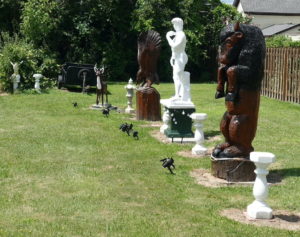We continue the series on walking Buffalo, from the intrepid couple who walked every day—no matter the weather—in the first 30 months of Covid. They think (without being systematic) they walked every street in Buffalo, and many in other cities and towns, taking some 20,000 photos, some of which are shared in this series. While not itineraries, we hope to encourage others to “walk the walk,” to see, observe and appreciate Buffalo—and beyond. William Graebner and Dianne Bennett are also 5 Cent Cine’s film critics, here.
Today’s Photo-Essay: The Yard as Spectacle
Yards are right there, in your face, every step of your walk. Many are interesting in one way or another, and some—especially if one escapes the toney Delaware District, where standards of decorum can limit one’s creativity (except, perhaps, in plants and flowers)—are spectacular, even bizarre.
Glenwood Avenue at Humboldt Parkway
There’s no better example of the yard as spectacle than this one (above) at the corner of Glenwood Avenue and Humboldt Parkway. Amid the flags (the red, black, and green one is the Pan-African flag, first flown in 1920) and goo-gahs of “Samantha Garden” are memorials to the deceased and photos of prominent African-Americans, including Muhammad Ali, Tommie Smith (who raised a black-gloved hand at the 1968 Olympics), and Malcolm X. The Pope is there, too, as are some faces I didn’t recognize. Across a small red Buffalo were the words, “All Lives Matters.” This yard can change dramatically from time to time.
Glenwood Avenue at Humboldt Parkway (closeup)
More restricted in scope, but no less spectacular, is the doubled cross of flowers (plastic, we assume) that dominates this yard on Beckwith Street at Madison, just off Sycamore. It’s a well-known feature of the neighborhood. A man passing by said he had visited the cross at least 40 times, and that it was especially dramatic when illuminated at night.
The East Side is also home to two sculpture gardens that occupy yards. One of them, visible from the 190 freeway in the Seneca/Babcock neighborhood, features a standing Buffalo, an eagle, and Michelangelo’s David.
The other, a work in progress, is centered around a fountain worthy of Florence or Rome, complete with cherubs and fish and—perhaps not from the Renaissance—a young woman at the very top. To the right in the photo, another sculpted young woman, this one demurely covering up. To the east, the Central Terminal suggests the location.
The plastic pink flamingo has been a popular feature of yards since 1957, when an art school graduate working for Union Products, a company specializing in “plastics for the lawn,” created the prototype. The first consumers of the product lived in working-class areas. Sixty-five years later, the pink flamingo remains a popular feature of area yards, usually with one or two birds poking around in the bushes.
This yard, in North Buffalo off Hinman Avenue, is the most elaborate we’ve seen—and one of the most patriotic, combining the flamingo with Uncle Sam, American flags, and a large “FREEDOM” sign. Many of the flamingos sport “flag” hats. Buffalo may have a special relationship to the pink flamingo. In June, the city, celebrating Frederick Law Olmsted’s 200th birthday, earned the Guinness World Record for the “longest line of garden flamingos” (FLOmingos), with 4280.
A corner yard at Michigan and Riley offers another sort of statement, at once patriotic and somber, honoring veterans of the Vietnam War, POW-MIAs, the Army and the Marines. A pair of combat boots hangs over what appears to be a military shield. The display has changed over the years.
Sometimes all the spectacle requires is one figure that seems to exist beyond the imagination. We found that figure in a back yard on Red Jacket and Perry Streets, in the Old First Ward. He appeared to be ready to put sausages on the grill. The rest of the property also deserves a look. The owner encouraged us to explore his unique yard.
We’re not connoisseurs of plants and flowers, yet we couldn’t help but admire this riot of Celosia, flourishing in late October on Best Street (yes, Best Street, near Wohlers, across from the barbed wire of a former youth detention center). This edible plant (I think I’ll stick with lettuce) is also known as Cock’s Comb. In Italy, it is sometimes called “penne [feathers] dei Carabinieri,” referring to the red, feather-like plumes on the ceremonial hats worn by members of the national police force.
We’ve got just one more spectacular yard, and we could have saved it for a separate piece on Christmas displays. It’s so over-the-top that it seemed better here, as the final entry in “the yard as spectacle.” You’ll have to go to Niagara Avenue, Niagara Falls (New York) in December to see this one.
Also see:
How to Take a Walk in Buffalo – Look Up! Roofs and Roofers
How to Take a Walk in Buffalo – Buffalo’s Mini-Marts
How to Take a Walk in Buffalo – Remembering 9/11
How to Take a Walk in Buffalo – Street Humor
© William Graebner
The post How to Take a Walk—in Buffalo, and Beyond (5th in the series) appeared first on Buffalo Rising.

